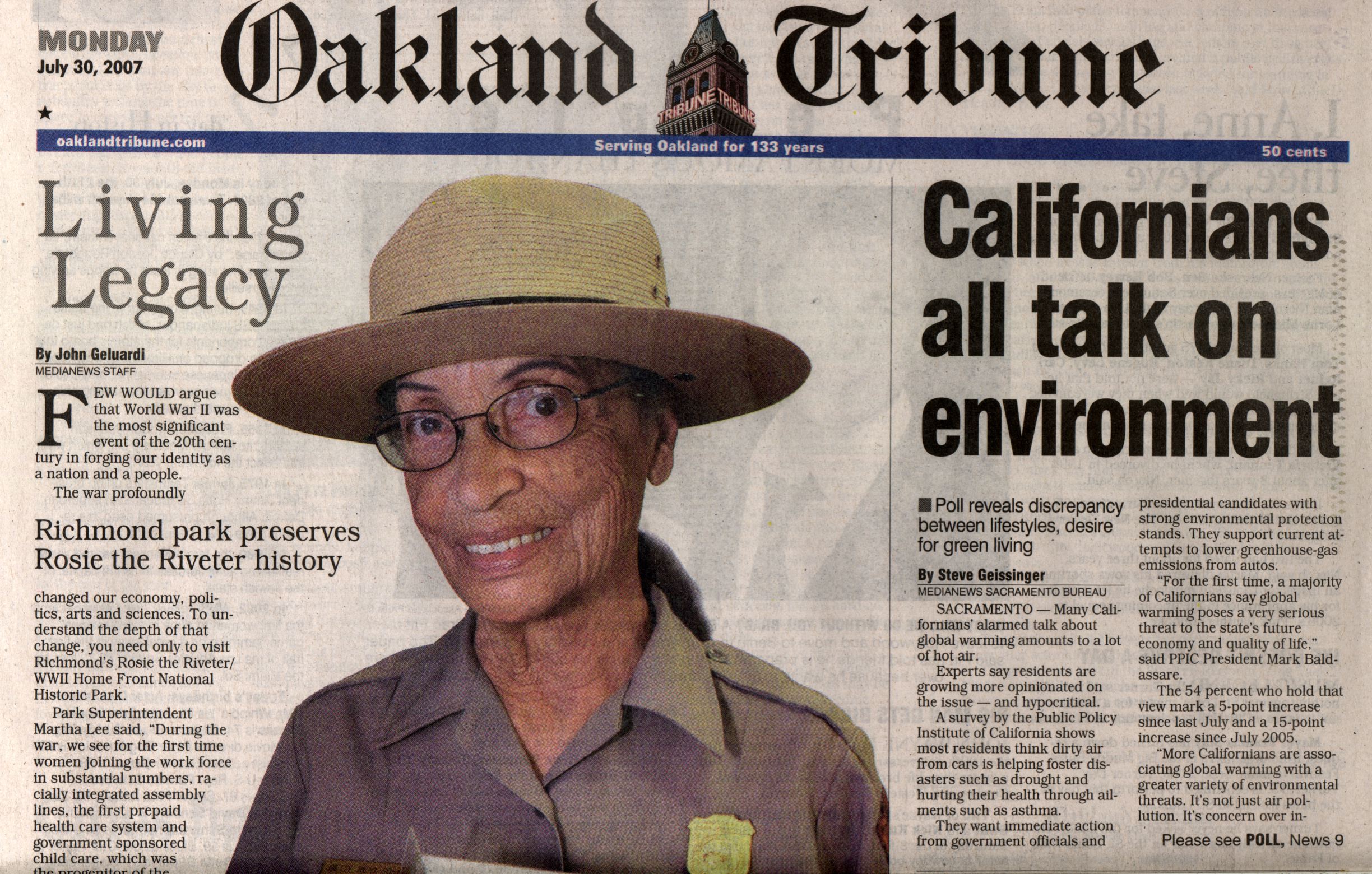
THE BETTY REID SOSKIN PAGES

RICHMOND PARK PRESERVES ROSIE THE RIVETER HISTORY
By John Geluardi
OAKLAND TRIBUNE
July 30, 2007
FEW WOULD argue that World War II was the most significant event of the 20th century in forging our identity as a nation and a people.
The war profoundly changed our economy, politics, arts and sciences. To understand the depth of that change, you need only to visit Richmond's Rosie the Riveter/WWII Home Front National Historic Park.
Park Superintendent Martha Lee said, "During the war, we see for the first time women joining the work force in substantial numbers, racially integrated assembly lines, the first prepaid health care system and government sponsored child care, which was the progenitor of the Head Start program. These things grew into powerful social movements after the war, and here in Richmond we have rich examples of how those seeds were planted."
Summer bus tours of the park give visitors broad insight into life in Richmond during the war through buildings, documents, artwork, welding artifacts, a Victory ship and even a near-mint condition wedding dress. The tours have been so popular that officials have added two more in August.
"The tours filled up really quickly, and we're still taking names on the waiting list," said program manager Lucy Lawliss. "We had this incredible response that we were not prepared for."
The park consists of numerous official locations, mostly on or near the city's waterfront, and dozens of unofficial sites. The tour takes visitors to Kaiser Shipyard No. 3, where there are five historic buildings, a 220-ton wartime whirley crane, the SS Red Oak Victory, and five dry docks where the Rosies helped build and launch ships.
Then the tour swings by thefirst Kaiser Hospital, the Maritime Child Development Center -- the first government-sponsored preschool and day care center -- and Atchinson Village, one of the first examples of public housing.
 The park tells so many histories that it attracts a wide variety of visitors, some interested in wartime industry, others in the social movements spawned during the war and some who simply want to experience nostalgia.
The park tells so many histories that it attracts a wide variety of visitors, some interested in wartime industry, others in the social movements spawned during the war and some who simply want to experience nostalgia.
"I came because I like the feeling of connection with my father's generation, which is quickly passing away," said Nancy Webb, a park visitor and Richmond resident. "I also love the feeling of being in history today."
Perhaps the park story with the most significance now is that of Rosie herself. It was during the war that women stepped into the huge industrial void across the country, manufacturing cars, tanks, ships and anything else needed in the war effort. Women smashed all myths of what their social roles should be.
Rosie's image has become a potent symbol of female empowerment. Consider this: When U.S. Rep. Nancy Pelosi, D-San Francisco, was sworn in as the first female speaker of the House, she wore the "We Can Do It" button depicting a determined Rosie with her denim sleeves rolled up over her well-muscled arms.
Presidential candidate Sen. Hillary Rodham Clinton, D-N.Y., also is capitalizing on the image by using it on campaign T-shirts, posters and coffee mugs.
One of the park's gems is 85-year-old interpreter Betty Reid Soskin, who during the war worked as a file clerk in the segregated Boiler Makers Auxiliary 36 union hall.
Soskin, who was hired by the National Park Service recently as a community outreach assistant, wore her dapper, forest-green Park Service uniform and broad-rimmed ranger hat for the first time during a recent tour.
"Wearing this uniform, I feel like I have some real authority," Soskin quipped with a broad smile. "I should be directing traffic or something."
Soskin has been a tireless voice for making sure the African- American wartime experience -- both the positive steps toward integration and the presence of discrimination -- has a prominent place in the park's history, Lee said.
"When I got here, some people thought Rosie was a park that commemorated the experience of white females during the war," Lee said. "Betty has challenged us to embrace all of our stories for better or worse. We need to look at the truth of our history, and Betty has been an inspiration for that."
Soskin kicked off the recent tour by showing a four-minute video, "Of Lost Conversations and Untold Stories," which she wrote and narrated. The short piece captures the pride African Americans felt when wartime ships were named after prominent black scientists, educators, poets and abolitionists.
"When the SS Robert T. Abbott, named for the publisher of the Chicago Defender, was launched, it was the social event of the year," Soskin said.
With the rise of women in business and politics, the significance of the park is bound to grow, Soskin said.
"The history we have in Richmond is just coming into itself," Soskin said. "The city will be able to re-imagine itself through this park. Richmond has no idea yet of her role in this nation's history."